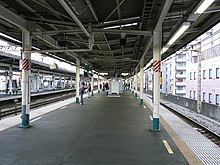Asagaya Railway Station
| Asagaya ( 阿佐 ケ 谷 ) | |
|---|---|
|
South entrance (August 2008)
|
|
| Data | |
| Location in the network | Through station |
| Platform tracks | 4th |
| abbreviation | JB05 / JC08 |
| opening | July 15, 1922 |
| location | |
| City / municipality | Suginami |
| prefecture | Tokyo |
| Country | Japan |
| Coordinates | 35 ° 42 '18 " N , 139 ° 38' 9" E |
| Height ( SO ) | 41 m TP |
| Railway lines | |
| List of train stations in Japan | |
The Asagaya Station ( Jap. 阿佐ケ谷駅 , Asagaya-eki ) is a station on the Japanese island of Honshu . It is operated by the JR East railway company and is located in the Suginami district of the capital Tokyo .
links
Asagaya is a through station on the Chūō main line from Tokyo via Shinjuku to Shiojiri , the tracks of which are identical to those of the Chūō high-speed railway line Tokyo – Shinjuku– Takao . In parallel, the Chūō-Sōbu line runs from Mitaka via Akihabara to Chiba . All three lines are operated by the JR East railway company. Between Mitaka and Nakano the SOBU Chuo-line is underground trains on the company Tokyo Metro shared leading to the Tozai-line by Nishi Funabashi- and Tsudanuma by bound are.
On the Chuo train line holding Kakueki-Teisha -Nahverkehrszüge and Kaisoku - fast trains . The starting points of these national connections are usually Tokyo in the east and Takao and Ōtsuki in the west. Some of these trains run beyond Ōtsuki to Kawaguchiko or switch to the Ōme line in Tachikawa . During the day nine connections per hour are offered, during rush hour the train sequence can be two minutes. On weekends, all of the trains mentioned run through without stopping. Local traffic through the inner Tokyo suburbs is handled on the Chūō-Sōbu line, which has its own tracks and is operationally independent of the other two lines. During rush hour, the train sequence is two minutes, with several trains running further west to Musashi-Koganei and only turning there. During the day, nine trains are offered every hour. At all times of the day - except during the morning rush hour and in the late evening - up to five subways of the Tōzai line run every hour via the nominal terminus Nakano to Mitaka.
The bus stops on the northern station forecourt are served by eight lines from the Kantō Bus company, those on the southern station forecourt by eight lines from the Seibu Bus , Toei Bus and Sugimaru companies .
investment
The station is on the border of Asagaya in the north and Asagaya-minami in the south. The system, located on a viaduct, faces east to west and has four tracks, all of which are used for passenger traffic. These are located on two covered central platforms , with the northern pair of tracks being reserved for high-speed and long-distance traffic and the southern pair of tracks for local traffic. The station building is located under the viaduct and is accessible from both sides; elevators and escalators lead up to the platforms. An underpass runs under the eastern end of the platforms.
In the 2018 fiscal year, an average of 46,069 passengers used the station every day.
Tracks
| 1 | ▉ Chūō-Sōbu line | Mitaka |
|
|
through-bound trains to Mitaka | |
| 2 | ▉ Chūō-Sōbu line | Nakano • Shinjuku • Akihabara • Nishi-Funabashi • Chiba |
|
|
Looped trains to Nakano • Iidabashi • Ōtemachi • Nishi-Funabashi • Tsudanuma | |
| 3 | ▉ Chūō rapid transit line | Mitaka • Tachikawa • Hachiōji • Takao |
| 4th | ▉ Chūō rapid transit line | Nakano • Shinjuku • Tokyo |
history
The private railway company Kōbu Tetsudō had opened the section between Shinjuku and Tachikawa as early as 1889, but the trains initially ran without stopping for over three decades. The residents of the village of Asagaya petitioned for the construction of a train station, which was successful, while the village chief was able to convince the landowners to surrender the required plots. Finally, on July 15, 1922, the Ministry of Railways opened it . Until the early 1960s, the facility was two-track and at ground level, and freight traffic was never handled here. On September 22, 1964, the Japanese State Railways initially relocated the existing double track to a viaduct . This was followed by the expansion of the Nakano - Ogikubo section to four tracks. The work was completed on April 3, 1966 and on April 28 of the same year the Chūō-Sōbu line was extended. As part of the privatization of the state railway, the station passed into the possession of the new railway company JR East on April 1, 1987 .
Adjacent train stations
|
←
|
Lines |
→
|
||
|---|---|---|---|---|
| Koenji |
(Monday – Friday only) JR East |
Ogikubo | ||
| Koenji |
|
Ogikubo | ||
Web links
- JR East Station Information (Japanese)
Individual evidence
- ↑ JR 時刻表 2019 年 3 月 号 (JR timetable March 2019). Kōtsū shinbunsha, Tokyo 2019.
- ↑ 各 駅 の 乗車 人員 (2018 年度). JR East , 2018, accessed December 17, 2019 (Japanese).
- ↑ 中 野 ~ 荻 窪 間 の 新 駅 は 、 「馬橋 駅」 に 決 ま っ て い た. Suginami District , April 15, 2006, accessed December 17, 2019 (Japanese).
- ↑ Tetsu Ishino (Ed.): 停車場 変 遷 大事 典 国 鉄 ・ JR 編 (station change directory JNR / JR) . JTB, Tokyo 1998, ISBN 978-4-533-02980-6 .


